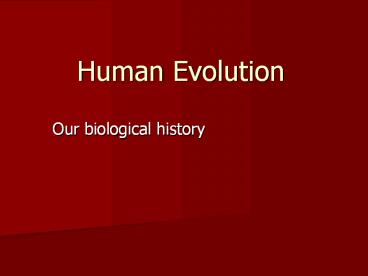Human Evolution - PowerPoint PPT Presentation
1 / 15
Title:
Human Evolution
Description:
Human Evolution Our biological history What is evolution? Evolution is change Biological evolution is change in the properties of a population over time Why ? – PowerPoint PPT presentation
Number of Views:387
Avg rating:3.0/5.0
Title: Human Evolution
1
Human Evolution
- Our biological history
2
What is evolution?
- Evolution is change
- Biological evolution is change in the properties
of a population over time
3
Why ?
- We discuss human evolution because
- Speculation about human history and the natural
world plays an important role in many societies - Culture is an expression on top of our biological
base - Biology and culture are intertwined complex
brains have evolved with complex social
organization - Our evolutionary history is part of what it means
to be human
4
Natural Selection
- Set of simple patterns that work together to
change a population over generations - Variation there is variation among members of a
species - Mutation variation arises from random changes
in genetic material - Gene flow when individuals move from place to
place and mix genes in new gene pools, this adds
to variation - Genetic drift in isolation or disaster,
whatever random genes made it through will be
passed on to future generations
5
Natural Selection
- Set of simple patterns that work together to
change a population over generations - Varied reproductive success
- Not all individuals survive to reproduce
- Those that do will pass traits on to offspring
- survival of fittest
6
Our Closest Relatives
- 25 20 mya LCA with monkeys
- 13mya LCA with great apes
- 7mya LCA with chimpanzees
- All primates originated as tree dwellers
- Opposable thumbs
- Depth perception
7
Primate Social Life
- Live in social groups with strong mother/infant
bond - Learn by mimicking mother
- Learn by playing refine physical and social
skills - Dominance hierarchies reduce conflict
8
Tool Use in Primates
- Vary by group, therefore learned
- Macaques wash food
- Chimpanzees use hammerstone to break nuts
- Chimpanzees use sticks to fish for termites
- Chimpanzees use leaves as sponges
9
Evolution of Humans
- Bipedalism differentiates us from other primates
- Requires restructuring of feet, legs, hips, spine
and skull - Frees hands to carry objects
- Improves view of surroundings
- Can walk efficiently over long distances
10
Evolution of Humans
- Australopithecines 4 mya to 1 mya
- Gracile
- 3.55 feet tall, 65-100 pounds, brains 1/3 size
of ours - Eastern and southern Africa
- Omnivores fruit, vegetables, insects, small
animals - Robust
- Larger, much heavier skulls and jaws, bigger
teeth - Adapted for chewing heavy, coarse material like
grasses, leaves and roots
11
Evolution of Humans
- Australopithecines 4 mya to 1 mya
- Gracile
- Robust
- Homo
- Homo habilis
- Larger brains, smaller teeth
- Oldowan stone tools
- Omnivores, hunted small animals, scavanged large
- May have migrated to Europe and China
12
Evolution of Humans
- Australopithecines 4 mya to 1 mya
- Gracile
- Robust
- Homo
- Homo habilis
- Homo erectus
- Larger body and brain in modern human range
- Use of tools and fire
- Omnivores, including hunting large animals
- Found in Africa, Asia and Europe
13
Evolution of Humans
- Australopithecines 4 mya to 1 mya
- Gracile
- Robust
- Homo
- Homo habilis
- Homo erectus
- Homo sapiens
14
Evolution of Humans
- Homo erectus 1.8mya 100kya
- Neanderthals 130kya 35kya
- Modern Humans 195kya
- Are Neanderthals modern humans of a separate
species? - Replacement model
- Multiregional model
- Hybridization model
15
Homo sapiens Culture
- Varied and efficiently made stone tools
- Compound tools ax head bound to handle
- Atlatl handle that increases power in spear
throwing - Symbolic and artistic artifacts
- Venus figurines 30 20kya, 40 figures
- Cave paintings
- Domestication of plants and animals
- When Ice Age populations declined people turned
to domestication - Dogs domesticated 10 to 14kya
- Rye farming begins in the Middle East 13kya

